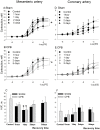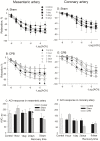S1P1 receptor modulation preserves vascular function in mesenteric and coronary arteries after CPB in the rat independent of depletion of lymphocytes
- PMID: 24819611
- PMCID: PMC4018292
- DOI: 10.1371/journal.pone.0097196
S1P1 receptor modulation preserves vascular function in mesenteric and coronary arteries after CPB in the rat independent of depletion of lymphocytes
Abstract
Background: Cardiopulmonary bypass (CPB) may induce systemic inflammation and vascular dysfunction. Sphingosine 1-phosphate (S1P) modulates various vascular and immune responses. Here we explored whether agonists of the S1P receptors, FTY720 and SEW2871 improve vascular reactivity after CPB in the rat.
Methods: Experiments were done in male Wistar rats (total n = 127). Anesthesia was induced by isoflurane (2.5-3%) and maintained by fentanyl and midazolam during CPB. After catheterization of the left femoral artery, carotid artery and the right atrium, normothermic extracorporeal circulation was instituted for 60 minutes. In the first part of the study animals were euthanized after either 1 hour, 1 day, 2 or 5 days of the recovery period. In second part of the study animals were euthanized after 1 day of postoperative period. We evaluated the contractile response to phenylephrine (mesenteric arteries) or to serotonin (coronary artery) and vasodilatory response to acethylcholine (both arteries).
Results: Contractile responses to phenylephrine were reduced at 1 day recovery after CPB and Sham as compared to healthy control animals (Emax, mN: 7.9 ± 1.9, 6.5 ± 1.5, and 11.3 ± 1.3, respectively). Mainly FTY720, but not SEW2871, caused lymphopenia in both Sham and CPB groups. In coronary and mesenteric arteries, both FTY720 and SEW2871 normalized serotonin and phenylephrine-mediated vascular reactivity after CPB (p<0.05) and FTY720 increased relaxation to acetylcholine as compared with untreated rats that underwent CPB.
Conclusion: Pretreatment with FTY720 or SEW2871 preserves vascular function in mesenteric and coronary artery after CPB. Therefore, pharmacological activation of S1P1 receptors may provide a promising therapeutic intervention to prevent CPB-related vascular dysfunction in patients.
Conflict of interest statement
Figures





Similar articles
-
Analysis of sphingosine 1-phosphate receptors involved in constriction of isolated cerebral arteries with receptor null mice and pharmacological tools.Br J Pharmacol. 2008 Jan;153(1):140-7. doi: 10.1038/sj.bjp.0707581. Epub 2007 Nov 19. Br J Pharmacol. 2008. PMID: 18026125 Free PMC article.
-
Protective effects of sphingosine-1-phosphate receptor agonist treatment after myocardial ischaemia-reperfusion.Cardiovasc Res. 2009 Jul 15;83(2):285-93. doi: 10.1093/cvr/cvp137. Epub 2009 May 5. Cardiovasc Res. 2009. PMID: 19416991
-
Changes in mesenteric vascular reactivity and inflammatory response after cardiopulmonary bypass in a rat model.Ann Thorac Surg. 2004 Jun;77(6):2130-7; author reply 2137. doi: 10.1016/j.athoracsur.2003.10.034. Ann Thorac Surg. 2004. PMID: 15172281
-
FTY720 (fingolimod) in Multiple Sclerosis: therapeutic effects in the immune and the central nervous system.Br J Pharmacol. 2009 Nov;158(5):1173-82. doi: 10.1111/j.1476-5381.2009.00451.x. Epub 2009 Oct 8. Br J Pharmacol. 2009. PMID: 19814729 Free PMC article. Review.
-
Production and release of sphingosine 1-phosphate and the phosphorylated form of the immunomodulator FTY720.Biochim Biophys Acta. 2008 Sep;1781(9):496-502. doi: 10.1016/j.bbalip.2008.05.003. Epub 2008 Jun 13. Biochim Biophys Acta. 2008. PMID: 18555808 Review.
Cited by
-
Differential Effects of Long Term FTY720 Treatment on Endothelial versus Smooth Muscle Cell Signaling to S1P in Rat Mesenteric Arteries.PLoS One. 2016 Sep 1;11(9):e0162029. doi: 10.1371/journal.pone.0162029. eCollection 2016. PLoS One. 2016. PMID: 27583547 Free PMC article.
-
Pharmacological Cardioprotection against Ischemia Reperfusion Injury-The Search for a Clinical Effective Therapy.Cells. 2023 May 20;12(10):1432. doi: 10.3390/cells12101432. Cells. 2023. PMID: 37408266 Free PMC article. Review.
-
Sphingosine-1-Phosphate Receptor-1 Selective Agonist Enhances Collateral Growth and Protects against Subsequent Stroke.PLoS One. 2015 Sep 14;10(9):e0138029. doi: 10.1371/journal.pone.0138029. eCollection 2015. PLoS One. 2015. PMID: 26367258 Free PMC article.
References
-
- Hirleman E, Larson DF (2008) Cardiopulmonary bypass and edema: physiology and pathophysiology. Perfusion 23: 311–322. - PubMed
-
- Sodha NR, Feng J, Clements RT, Bianchi C, Boodhwani M, et al. (2007) Protein kinase C alpha modulates microvascular reactivity in the human coronary and skeletal microcirculation. Surgery 142: 243–252. - PubMed
Publication types
MeSH terms
Substances
LinkOut - more resources
Full Text Sources
Other Literature Sources

